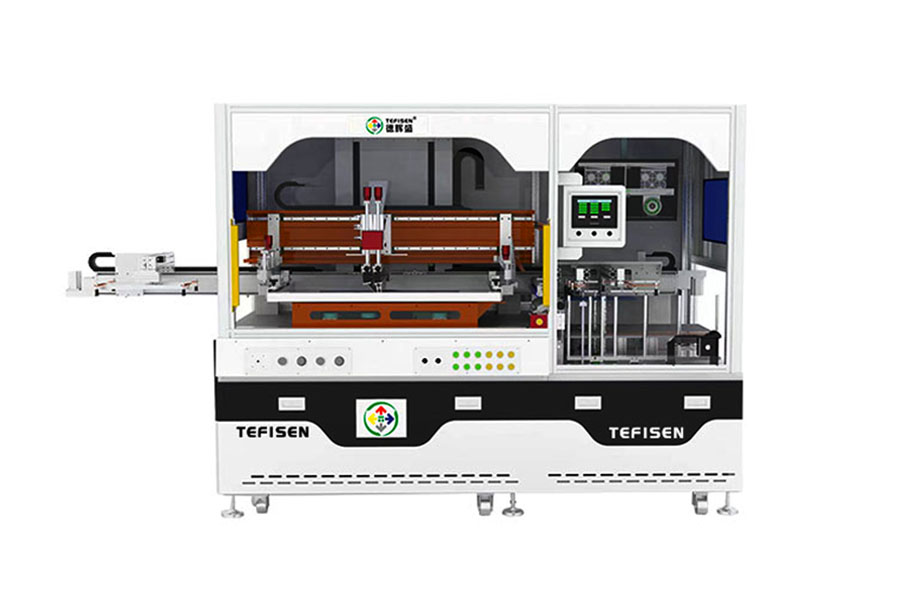Revolutionizing Auto Screen Printing Machines with CCD Vision
Are you facing recurrent issues with your screen printing machines, such as inaccurate alignment, low production efficiency, high labor costs, and inconsistent product quality?
Addressing these challenges, Tefisen introduces The auto screen printing machines with CCD vision TFS-AS668F, a solution widely acclaimed by customers for its high-precision alignment, automated feeding and unloading, superior printing accuracy, high productivity, and reduced manpower requirements. The auto screen printing machines with CCD vision is a high-precision screen printing equipment specifically designed for automated line printing of single-sheet materials. It utilizes robotic arms for material handling, achieving an astonishing alignment accuracy of ±0.02mm, significantly enhancing production yield. Coupled with a robust yet lightweight machine structure, imported servo motors and transmission systems, as well as precision guidance and positioning, the machine operates stably, quietly, and swiftly.

I. Working Principle
The auto screen printing machines with CCD vision functions by capturing images of feature positions on products using a dedicated CCD camera, industrial lens, and light source. An image processing unit (PC) analyzes these images, calculates the actual position of the product through positional algorithms, and compares it with a preset reference position to determine the actual deviation. Subsequently, it controls the movement of the alignment platform to reposition the product precisely onto the reference position, ensuring rapid, closed-loop, and highly accurate alignment.
II. Product Features
1. High-Precision Alignment
The core strength of this machine lies in its CCD image-based automatic alignment technology. This advanced vision system guarantees pinpoint accuracy in alignment, ensuring the precision and consistency of printed patterns within ±0.02mm, thereby safeguarding high-quality printing.
2. Stable Machine Structure
The machine boasts a robust yet lightweight structure, equipped with imported servo motors, transmission systems, and precision guidance, ensuring stability during operation. This stability not only enhances printing quality but also minimizes breakdowns and extends the equipment's lifespan. Although the initial investment might be higher, its reliable performance and longevity translate into lower maintenance and replacement costs over the long term, offering excellent value for money.
3. Premium Printing Table
The printing table adopts a one-piece cast aluminum design with a flatness of ±0.07mm, ensuring uniform film thickness and consistent printing results. This material choice balances quality and cost-effectiveness, providing reliable performance without resorting to excessively expensive specialized materials.
4. Advanced Printing Block Design
The printing block utilizes a cast pillar combined with precision linear guides and synchronous locking mechanisms, further ensuring uniformity in film thickness. This design elevates printing precision and stability, laying a solid foundation for superior printing quality. While precision design adds to manufacturing costs, it reduces unit production costs by enhancing efficiency and quality.
5. Constant Pressure Printing
The integration of servo motor-driven screen lifting and a precision digital constant pressure printing head ensures consistent pressure application, enhancing print quality and minimizing screen damage. Reduced screen wear translates into fewer replacements, thereby saving costs.
6. Automated Feeding and Unloading Sections
Designed exclusively for automated line printing of single sheets, these sections significantly boost productivity and quality yield by automating material handling. While the addition of these sections may increase initial costs, they drastically lower labor expenses, resulting in overall cost savings.
7. Safety Design
The machine incorporates safety features like auto-reset, error detection systems, safety light curtains, emergency stop buttons, and warning lights, providing comprehensive protection for operators. Safety investments are crucial for preventing costly accidents and ensuring long-term cost savings.
III. Product Performance Parameters
(Specific performance parameters would typically include technical details such as maximum printing size, resolution, printing speed, power requirements, etc., which are not provided in the original text. These details would be crucial for a comprehensive understanding of the machine's capabilities.)
| Specification | Details |
| Equipment Model | TFS-AS668F |
| Printing Table Size | 620×800mm |
| Maximum Printing Area | 500×700mm |
| Minimum Printing Area | 120×150mm |
| Printing Thickness | 0.075-5mm |
| Table Level Accuracy | ±0.08mm |
| Table Suction Area | 520×720mm |
| Suction Hole Diameter | ∮0.8mm |
| Suction Hole Spacing | 15×15mm |
| Printing Method | Single Squeegee + Single Lift-net |
| CCD Imaging Range | 120-150mm |
| CCD Camera Field of View | 12×9mm |
| Number of Alignment Cameras | 2 |
| Image Alignment Accuracy | ±0.005mm |
| Integrated Accuracy | ±0.02mm |
| Alignment Integration Time | <1sec |
| Maximum Frame Size | 900×1450mm |
| Screen Frame Thickness | 30-40mm |
| Screen Frame Height (Cleaning Position) | 250mm |
| Table Height | 900±30mm |
| Squeegee Pressure | 1-6kg |
| Lift-net Clearance | 0-10mm (Manual) |
| Printing Screen to Table Distance | 0-15mm (Set via HMI) |
| Printing Stroke | 0-700mm (Set via HMI) |
| Squeegee Angle | 60-90° |
| Power Supply | 3∮, 220v/380v, 50/60Hz |
| Power Consumption | 3.5kw |
| Compressed Air Source | 5-6kg |
| Air Consumption | 70L/Min |
| Machine Weight | 1500kg |
| Machine Dimensions (L×W×H) |
2450×1650×2200mm
(Excluding unloading robot length);
3.2 meters with unloading robot attached
|
IV. Differences between Auto Screen Printing Machines with CCD Vision and Ordinary Screen Printer
| Comparison Items | Conventional Silk Screen Printer | Auto Screen Printing Machines with CCD Vision |
| Alignment Accuracy | Lower, difficult to achieve ±0.02mm | High-precision alignment within ±0.02mm |
| Machine Structure | Relatively less stable | Sturdy, lightweight, with imported servo and drive motors, precise guidance and positioning, operates stably, quietly, smoothly, and quickly |
| Printing Table Surface | May have lower flatness | One-piece cast aluminum material, table flatness ±0.07mm, good uniformity of printing film thickness |
| Printing Base Design | Relatively simple, may struggle to ensure even film thickness | Designed with precision linear guide rails, synchronous locking devices, and cast pillars, ensuring uniform film thickness |
| Printing Pressure Control | May be uneven | Servo motor lift-net and traditional printing combined with high-precision digital constant pressure printing head, providing excellent constant pressure control |
| Automatic Loading/Unloading | May require significant manual operation | Automatic loading and unloading sections, enhancing productivity and quality yield, reducing manual intervention |
| Safety Design | Fewer safety measures | Equipped with safety reset, automatic error detection system, safety light curtains, emergency stop buttons, warning light towers, and other safety features |
V. Applications of Auto Screen Printing Machines with CCD Vision
The auto screen printing machines with CCD vision is primarily used for automatic screen printing of sheet materials such as PET, PC, acrylic, etc. It enables automation, reduces manpower, and enhances efficiency. It has broad application prospects in fields requiring high-precision printing, such as electronics, advertising signage, packaging printing, etc.
VI. Workflow of Auto Screen Printing Machines with CCD Vision
1. Loading: Place the sheet material to be printed on the loading position of the screen printer.
2. Positioning: The CCD camera takes a picture of the sheet material, captures its position information, and compares it with the preset reference position to calculate the offset.
3. Alignment: Based on the calculated offset, control the alignment platform to move, precisely aligning the sheet material to the printing position.
4. Printing: After the sheet material is aligned, the screen printer starts printing, transferring ink through the stencil onto the sheet material to form the desired pattern or text.
5. Unloading: After printing, remove the sheet material from the screen printer, completing the printing process.
VII. Pre-Printing Operation Regulations
1. Pre-Printing Operations
o Before turning on the machine, check if the power cords are properly connected, if the grounding wire is reliably grounded, and if there are any loose screws.
o Check if the air source pressure is normal (0.5 - 0.8MPa); inspect the water trap of the air source duplex filter for accumulated water.
o Ensure the oil mist lubricator has the correct oil level (1/3 - 2/3 of the inkcup).
o Turn on the main switch; the power light indicates power is connected.
o Turn on the suction pump switch to verify its proper functioning.
o Manually operate the machine to ensure smooth movement in all directions.
2. Pre-Printing Screen Preparation
o Verify that the screen pattern matches the product sample.
o Adjust the screen frame clamps to the appropriate position, install the screen, squeegee, and flood bar, level the screen frame, and adjust the distance between the screen and platform for precise printing.
o Manually adjust the printing stroke, speed, squeegee, and flood bar pressure. Once adjusted, secure the screen and platform to prevent shifting.
3. Pre-printing Trial Run Regulations
o Place the substrate in the center of the printing platform at an appropriate position, align it with the pattern on the screen first, and then position the substrate securely.
o Conduct a manual trial run, adjusting the pressure of the squeegee and flood bar until the pattern appears clearly and maintains consistent color around the edges. Further adjustments should be made subsequently based on the printing condition.
o After confirming that the above checks are error-free and the surrounding work environment is safe, proceed with semi-automatic or fully automatic printing operations using the foot pedal switch.
o Upon completion, remove the screen and use a cloth to wipe clean all parts of the machine.
VIII. Precautions for Equipment Operation
1. Always cut off the main power switch of the machine before cleaning, maintenance, or repairs.
2. In case of emergency stop during machine operation, press the front safety pressure plate or safety rail, which will automatically stop the machine and return the printing frame to its upper position.
3. Conduct daily spot checks and maintenance on the flat screen printing machine, and fill in the records on time.
4. Safety warning labels are affixed to different positions of the machine to remind relevant personnel of safety precautions during installation, operation, or maintenance. The following safety warning labels are used on this machine:
(1) Do not touch your hands or other objects when the squeegee head is descending.
(2) During automatic printing, never insert your hands or head into the machine. In case of emergency, immediately press the emergency stop button to halt the printing.
(3) Do not start the machine if the safety devices are not functioning properly.
IX. Maintenance and Servicing of Auto Screen Printing Machines with CCD Vision
1. Inject lubricant into the horizontal printing guide rail once every week (approximately 60 hours) of operation.
2. For the vertical lifting column guide shaft, inject lubricant once every week (approximately 60 hours) for semi-automatic printers and once every month for fully automatic printers.
3. Inject lubricant into the squeegee arm lifting and lowering tracks once every week (approximately 60 hours) of operation.
4. Inject lubricant into the suction cylinder moving slide once every month of operation.
5. Add lubricant to the drying oven, feeder, and transmission chains once every three months of operation.
6. Keep the machine exterior clean regularly to prevent damage from printing ink, thinner, screen cleaning solution, thinner, etc.
X. Conclusion:
The auto screen printing machines with CCD vision brings new innovations to the sheet material printing industry with its outstanding performance and innovative technology. By utilizing CCD image automatic alignment technology, it achieves high-precision alignment, complemented by a sturdy yet lightweight machine structure, high-quality printing table, advanced printing seat design, constant pressure printing effect, automatic feeding and discharging sections, and safety designs. These features confer significant advantages in printing accuracy, production efficiency, product quality, and safety. The Auto screen printing machines with CCD vision holds vast potential for application in the sheet material printing field and will play a crucial role in promoting the intelligent and automated development of the industry.

